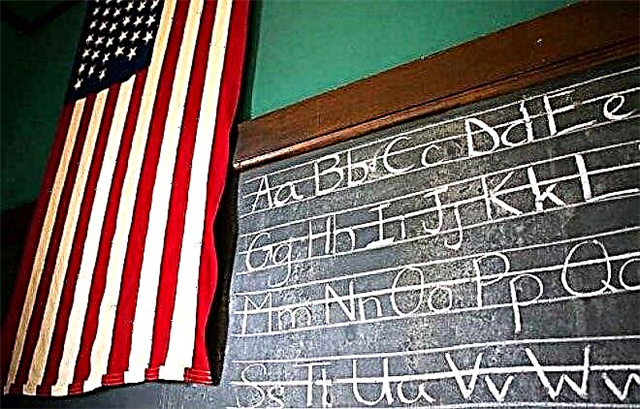The United States of America ranks among the international leaders in the quality of education. According to the United Nations, the education system in the United States in 2021 had an Education Index of 0.903 with the maximum possible value of 1. A large number of foreigners tend to enroll in American higher education institutions.

Specificity of the American educational system
In the United States, the educational system is not controlled centrally (by the Department of Education), but at the local level. Each state has an elected office that draws up curricula and oversees their implementation. The function of the federal government is limited only to funding educational institutions that are public.
The American educational model is based on the Liberal Arts principle. It involves students' independent choice of life values and bearing responsibility for this choice. Even at school, students have the right to study those subjects that will be useful to them in obtaining a future specialty.
In American educational institutions, the number of hours of theoretical courses is kept to a minimum. Most of the lessons are practical: students are given specific life tasks that they have to solve using the existing knowledge.
The stages of study in America are: early childhood education, primary school, high school and higher education. We will discuss them in more detail later.
Preschool institutions
Preschool education is the first stage, which is known as Preschool. Within its framework, there are nursery groups for children from 2 years old, day schools and care centers for children who have reached 3-4 years old.
Some of these establishments are open 24 hours a day. Their visit, as in most countries, is optional.
Kindergartens in the United States operate on a commercial basis. The average monthly fee ranges from $ 850-1,200.
Preschool education in America is aimed at the all-round development of every child. Educators help children learn to speak correctly, play with them, teach them to dance, draw, stage scenes, and so on. There is no clear educational program for such centers.
From the age of 5, every child can attend kindergarten. Most of them work at schools.
The preparatory groups are free and funded by the government of each state. Here children are prepared for school, taught to read, count, write, help to adapt in a team. In parallel, there are also private paid training centers.
Many states practice the issuance of certificates of preschool education. They indicate the name of the institution that the child attended, the period of study, the characteristics of behavior and abilities are given. In some primary schools, such a certificate is a prerequisite for enrollment.
Primary School
 Primary education in the United States is compulsory, it is known as Elementary School. Training lasts for 5 years: from 1st to 5th grades. All children must attend primary school from 6 to 11 years old.
Primary education in the United States is compulsory, it is known as Elementary School. Training lasts for 5 years: from 1st to 5th grades. All children must attend primary school from 6 to 11 years old.
Students are assigned to classes after passing an IQ test based on their ability. Primary schools in the United States include public, private, and parish educational institutions.
The training program includes the following academic disciplines:
- arithmetic;
- letter;
- reading.
Little time is devoted to social and natural sciences. Most often they are combined in such a subject as local history.
All disciplines are taught by one teacher. The only exceptions are music, art and physical education. The quality content of the program is not regulated at the state level.
In many states, primary schools spend a lot of time on field trips, art projects, and other recreational teaching methods.
Many immigrants from Russia are interested in whether there are Russian schools in America. It should be noted that there are no educational institutions in the country where teaching would take place exclusively in Russian. Nevertheless, there are charter (contract) schools, the curriculum of which includes the Russian language and literature.
Such establishments are public and free. But unlike conventional American schools, they are independent and free from many restrictions. Charter schools are designed for a small number of people: from 200 to 400 students.
High school
Secondary Education in the United States consists of two stages: junior high school and high school senior.
The specifics of junior high school
The Middle School provides for the education of children for 3 years - from 6th to 8th grades. That is, students attend junior high school from 11 to 13 years old.
Compulsory subjects include English, mathematics, natural and social sciences, physical education. Junior high school in the United States provides for the formation of classes with different biases. Those with special abilities in a particular discipline attend classes with in-depth study of it.
In the 8th grade, students are given the right to independently choose some of the subjects that they would like to study. The choice must be made between art, foreign languages, technology.
Features of high school
 After graduating from the 8th grade, it is time for High School - high school.
After graduating from the 8th grade, it is time for High School - high school.
Both compulsory for everyone and specialized disciplines are taught here, which are chosen by the students themselves.
To obtain a certificate of education, each student must fulfill the following minimum requirements:
- study mathematics for 3 years;
- complete a 4-year literature course;
- from 2 to 4 years take a course in social sciences, including the history and government of the United States;
- complete a 1-2 year physical education program.
The core disciplines presented at the choice of students include:
- computer science;
- computer graphics and web design;
- statistics;
- editorial and journalism;
- theatrical art;
- dancing;
- foreign languages;
- art;
- labor training and others.
Senior high school must be attended for 4 years - from 9th to 12th grades. Teenagers aged 14-18 study here. Thus, it becomes obvious at what age Americans graduate from school.
Some schools in the United States provide for the 13th grade - the so-called Advanced Placement Program. It can be attended by those who have a desire to study more deeply the disciplines that will be specialized in the university.
After graduating from the 13th grade and passing the exam for at least 3 points out of 5 maximum, you can immediately enter the second year of the university. Students who graduate from this class with honors are eligible for admission to Princeton, Yale, Harvard universities.
Training under such a program provides benefits for admission to universities not only in the United States, but also in Canada, Great Britain and over 50 other countries.
The complete answer to the question of how many classes there are in American schools is 12, with the option to extend studies in the 13th grade under the Advanced Placement Program.
The road to the country's prestigious universities opens up for graduates of boarding schools. These are private elite educational institutions with permanent residence of students, where it is possible to study in depth a certain set of disciplines. Their advantage is small classes, designed for no more than 15 people.
The teaching staff is highly professional.Famous boarding schools in the United States: Berkshire School, Hoosac School, Cheshire Academy (IB School), Lawrence Academy, Wyoming Seminary Prep School.
School final exams
After graduating from high school, students must pass the Scholastic Aptitude Test - SAT I or SAT II final exam. The difference between these two types of tests is the focus and level of difficulty:
- SAT I is taken by those who plan to go to colleges or middle-level universities;
- SAT II must be passed by those who are going to continue their studies at the best universities in the country.
After passing exams in American schools, graduates receive diplomas of complete secondary education.
American higher education system
 Higher education in the United States is structured according to this structure:
Higher education in the United States is structured according to this structure:
- Bachelor's Degree. The program is designed for 4 years, includes 30 subjects. Upon graduation, students defend graduation projects, receive diplomas and a bachelor's degree.
- Master's Degree. The training lasts 1-2 years. Students are engaged in scientific projects in their chosen field of knowledge. Based on the results of studies, exams are passed. Graduates receive diplomas and a master's degree. Economists are awarded the Master of Business Administration (MBA) degree.
- Doctorate (Advanced Professional Degree). Having received a higher education in the United States on a master's program, you can enroll in doctoral studies. You need to study here for 2-3 years, the training ends with the defense of a thesis and the assignment of a PhD (Doctoral Level) degree to the graduate.
- Postgraduate / Postdoctoral Level Doctorate. This is the highest and most prestigious degree. Only those who have PhD degrees are eligible to study under this program, as well as a large number of research papers and projects.
American university degrees are quoted all over the world.
Popular higher education institutions
Universities that offer only bachelor's programs, are engaged exclusively in teaching students, without practicing research activities, are called colleges. Popular are Richard Bland College (Petersburg, Virginia), Baruch College (New York, NY), Hunter College (New York, NY) and others.
Liberal arts colleges are also known as "liberal arts colleges". Among the most popular according to the ranking of 2021:
- Williams (Williamstown, Massachusetts);
- Amherst (Amherst, Massachusetts);
- Swarthmore (Swarthmore, PA) and Wesley (Massachusetts).
Universities are higher education institutions that, in addition to undergraduate degrees, have master's and doctoral degrees. One university can have several colleges; for example, there are 14 of them at Yale University.
Distinguish between private universities and state universities. Among the first, the most authoritative (not only on a national but also on a global scale) are universities that are members of the Ivy League. These are 8 universities:
- Brownovsky (Providence, Rhode Island).
- Harvard (Cambridge, Massachusetts).
- Dartmouth (Hanover, New Hampshire).
- Yale (New Haven, Connecticut).
- Columbia (New York, NY).
- Cornell (Ithaca, NY).
- Pennsylvania (Philadelphia, Pennsylvania).
- Princeton (Princeton, NJ).
Among the popular universities of private ownership are the universities of New York: City, Rockefeller, Yeshiva and others.
State universities are funded by local governments. They are focused on educating the residents of their state. Tuition fees for representatives of other states in them are higher.
Some of the most popular universities of this type are California (Berkeley), Michigan (Ann Arbor), Virginia (Charlottesville) universities.
The quality of education in the United States depends on the form of ownership of the university. As practice shows, in the universities of the state there are more groups, teachers pay much less attention to each student, which is why the quality of teaching suffers.
Length of the academic year in the USA
 In most schools, the school year starts in late August - early September and lasts about 170-186 days (depending on the state). Children attend school from Monday to Friday.
In most schools, the school year starts in late August - early September and lasts about 170-186 days (depending on the state). Children attend school from Monday to Friday.
The schedule is designed for 5-6 hours a day. One lesson lasts 30-45 minutes, break - 2-5 minutes, lunch break - 30 minutes.
Answering the question about how long a vacation in the United States lasts, let us clarify that their duration differs in different states - there is no single state vacation scheme.
Summer holidays usually begin in late May - early June and last about 10 weeks on average. In the middle of the year, there are holidays for the holidays: Thanksgiving (4 to 5 days), Christmas (about 14 days), Easter (about 7 days).
The academic year is divided into two semesters, and in some universities, into three terms. There are universities in which a 4th - year - semester is introduced, which is optional.
American grading system
The grading system in US schools is an alphabetic, five-point system.
| Letter designation of grades | Decoding |
|---|---|
| A | Fine |
| V | Good |
| WITH | Average |
| D | Satisfactorily |
| F | Unsatisfactory |
The designations P (pass) and N (fail) are also used.
Teachers are not allowed to announce student scores in front of the entire class. It is believed that each student should monitor exclusively their own progress, and that a person's motivation can be affected by any comparison.
The academic grading system in the United States is also letter-based. Each letter means a certain percentage of knowledge.
| Letter designation | Percentage of knowledge | Equivalent in the traditional grading system |
|---|---|---|
| A | 95 to 100 | 5 |
| A- | 90 to 94 | 5 |
| B + | 85 to 89 | 4 |
| V | 80 to 84 | 4 |
| V- | 75 to 79 | 4 |
| C + | 70 to 74 | 3 |
| WITH | 65 to 69 | 3 |
| WITH- | 60 to 64 | 3 |
| D + | 55 to 59 | 3 |
| D | 50 to 54 | 3 |
| F | 0 to 49 | 2 |
Scores up to 60% of knowledge (that is, those that are located on a scale below C) fall into the category of not passing.
How much does it cost to study in the USA?
In a private university, the average cost of tuition in the United States per year ranges from $ 15,000 to $ 35,000. In some universities, this amount reaches $ 50,000. Education at state universities is cheaper: from $ 10,000 to $ 20,000 per year. This does not include accommodation, the cost of textbooks and other student expenses.
To “reduce the cost” of studying at a higher educational institution, you can study at a college for the first two years, and then enter the third year of university. College tuition fees range from $ 5,000 to $ 7,000 per year.
Free study in the United States is possible in three cases: if the applicant won a grant, received a personal scholarship, or got a job on the university campus.
English courses in the United States
In American language schools, everyone, including foreigners, have the opportunity to take courses aimed at deepening their knowledge of English and improving their speaking skills. Language courses in the USA can be:
- general;
- academic;
- for business;
- for passing TOEFL, IELTS exams;
- for teachers, doctors, representatives of other professions, and so on.
The cost of general courses is from 200 to 350 dollars per week, specialized - from 300 to 500 dollars.
In the United States, there are summer language schools and camps in which children and adolescents from various countries have the opportunity to undergo high-quality language training.
Summer education in America is also carried out in accordance with the combined programs: "English and Sports", "English and Photography", "English and Theater Arts" and so on.
Interesting facts about the American education system
 We bring to your attention a selection of the most interesting facts about education in the United States:
We bring to your attention a selection of the most interesting facts about education in the United States:
- The difference between education in the United States and Russia is that there is no holiday in America that symbolizes the beginning of the school year (analogous to September 1). In different states, children start school at different times (as discussed earlier).
- Admission to many public schools is based solely on the place of residence.If parents want to send their child to an educational institution located in a certain area, but they themselves live in another, they need to purchase housing near the school. That is why the quality of education is one of the pricing factors for residential real estate in the United States.
- The government of the country spends on average about 12,000 dollars per year for each student who enrolls free of charge.
- A second education in the United States can be obtained by foreigners who are under 35 years old.
- The Civil Rights Commission in the United States monitors college enrollment for both males and females. If the number of boys or girls exceeds 60%, their admission is discontinued.
- In American universities, it is allowed to study in two specialties at once. At the same time, you can get either two complete higher educations or one complete (major) and one incomplete (minor) professional education in the United States.
- At the time of entering the university, the applicant does not need to know what specialty he wants to study. If a person is undecided, he must put the status undeclared in the questionnaire. During the first two courses, all students attend general education subjects, so there is time to choose a profession.
Today in American universities you can register for the next semester online. Students have the right to choose the teachers whose subjects they want to attend, based on the rating presented on the website of the educational institution.
Conclusions
Let's list the pros and cons of American education. So, its advantages include:
- great attention to personality formation;
- play training;
- strict confidentiality at all levels of education;
- high quality educational services (for example, the majority of teachers at universities are holders of a doctoral degree);
- orientation to individual preferences, abilities and skills of students and their future profession;
- recognition of American diplomas throughout the world;
- deep integration with employers and broad employment prospects;
- availability of grants and scholarships.
Among the main disadvantages are:
- high tuition fees;
- high competition for prestigious universities;
- the problem of lagging public universities behind private ones in terms of the quality of educational services;
- significant workload on students;
- high cost of textbooks.
However, the number of people traveling from overseas to the United States for education is not decreasing. After all, a diploma from an American university allows you to count on work in almost any country.











